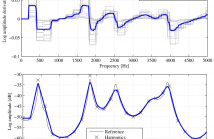ICASSP is the world's largest and most comprehensive technical conference on signal processing and its applications. It provides a fantastic networking opportunity for like-minded professionals from around the world. ICASSP 2016 conference will feature world-class presentations by internationally renowned speakers and cutting-edge session topics.
ICASSP 2016 presentation, Session: IVMP-P8 - Interpolation and Super-Resolution, Tursday, March 24, 13:30-15:30
- Categories:
 13 Views
13 Views- Read more about Transmit radiation pattern invariance in MIMO radar with application to DOA estimation
- 1 comment
- Log in to post comments
ICASSP 2016 presentation, Session: SAM-P1 - MIMO Radar, Tuesday, March 22, 16:00-18:00
- Categories:
 17 Views
17 Views- Read more about Cramer-Rao bound for sparse signals fitting the low-rank model with small number of parameters
- Log in to post comments
ICASSP 2016 presentation, Session: SPTM-P14 - Compressed Sampling and Sparsity, Friday, March 25, 8:30-10:30
ICASSP2016.pdf
- Categories:
 7 Views
7 Views
- Read more about A Time Regularization Technique for Discrete Spectral Envelopes Through Frequency Derivative
- Log in to post comments
Abstract—In most applications of sinusoidal models for speech
signal, an amplitude spectral envelope is necessary. This envelope
is not only assumed to fit the vocal tract filter response as
accurately as possible, but it should also exhibit slow varying
shapes across time. Indeed, time irregularities can generate
artifacts in signal manipulations or increase improperly the
features variance used in statistical models. In this letter, a
simple technique is suggested to improve this time regularity.
- Categories:
 11 Views
11 Views- Read more about ON PARAMETER ESTIMATION OF SYMMETRIC ALPHA-STABLE DISTRIBUTION
- Log in to post comments
- Categories:
 15 Views
15 ViewsFilter Bank Multi-Carrier (FBMC) modulation is considered as a possible candidate for 5G. Compared to OFDM, channel estimation becomes more challenging in FBMC due to the imaginary interference, which has to be canceled at the pilot positions either by auxiliary pilot symbols or coding.
- Categories:
 28 Views
28 Views
- Read more about LEARNING COMPACT STRUCTURAL REPRESENTATIONS FOR AUDIO EVENTS USING REGRESSOR BANKS
- Log in to post comments
We introduce a new learned descriptor for audio signals which is efficient for event representation. The entries of the descriptor are produced by evaluating a set of regressors on the input signal. The regressors are class-specific and trained using the random regression forests framework. Given an input signal, each regressor estimates the onset and offset positions of the target event. The estimation confidence scores output by a regressor are then used to quantify how the target event aligns with the temporal structure of the corresponding category.
- Categories:
 5 Views
5 Views
- Read more about Towards Multi-rigid Body Localization
- Log in to post comments
In this paper we focus on the relative position and orientation estimation between rigid bodies in an anchorless scenario. Several sensor units are installed on the rigid platforms, and the sensor placement on the rigid bodies is known beforehand (i.e., relative locations of the sensors on the rigid body are known). However, the absolute position of the rigid bodies is not known. We show that the relative localization of rigid bodies amounts to the estimation of a rotation matrix and the relative distance between the centroids of the rigid bodies.
- Categories:
 15 Views
15 Views- Read more about Dictionary Learning from Phaseless Measurements
- Log in to post comments
We propose a new algorithm to learn a dictionary along with sparse representations from signal measurements without phase. Specifically, we consider the task of reconstructing a two-dimensional image from squared-magnitude measurements of a complex-valued linear transformation of the original image. Several recent phase retrieval algorithms exploit underlying sparsity of the unknown signal in order to improve recovery performance.
- Categories:
 10 Views
10 Views
- Read more about A Data Set Providing Synthetic and Real-World Fisheye Video Sequences
- Log in to post comments
In video surveillance as well as automotive applications, so-called fisheye cameras are often employed to capture a very wide angle of view. To be able to develop and evaluate algorithms specifically adapted to fisheye images and videos, a corresponding test data set is therefore introduced in this paper. The sequences are freely available via www.lms.lnt.de/fisheyedataset/.
- Categories:
 57 Views
57 Views